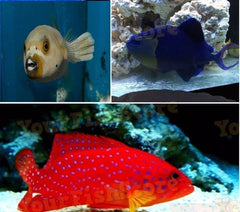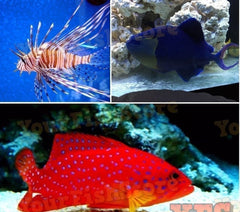X10 Assorted Jellybean Parrot Cichlid Fish - Freshwater Live
Ebay
$ 233.54 $ 278.65

X10 ASSORTED JELLYBEAN PARROT CICHLID FISH - FRESHWATER LIVE - FREE SHIPPING
They will be scooped out our holding tanks. We cannot guarantee we will be able to scoop ALL different types, but we will try to get a good variety.
*THIS ORDER IS FOR TEN JELLY BEAN CICHLIDS
Tank Size Required
30 Gallons Minimum A good rule of thumb is 30 gallon for one and 10 more gallons for each additional Blood Parrot. As with any fish, the bigger the tank the better.
Size and Growth
6 - 9" (15 - 24cm) Blood Parrots grow slow when compared to other Central American Cichlids or Flowerhorn. Once they hit 4-5" their growth slows further. They typically can live anywhere from 5 - 15 years depending on the care given to them and other genetic factors. When Blood Parrots are small they may show a tan/brown body color with black spots near the tail. These are simply juveniles that should change to orange/yellow as they grow.
Water Conditions
Temperature: 76 - 86F (24 - 30C) pH: 6.0 - 8.5 Temperatures should be between 76 - 86F (24 - 30C) but the ideal temperature should be between 82 - 84F (26 - 29C). Temperatures lower than 80F (24C) seems to cause them to be more reclusive and cause the color to be more pale. The ideal pH should be between 7.0 - 8.0.
Feeding
Blood Parrots enjoy pelleted foods with occasional Blood Worm and Shrimp treats. A smaller pellet size should be used due to their mouths. Recommended pellet brands are Hikari Cichlid or New Life Spectrum Cichlid/Cichlasoma Formula 1 - 3mm depending on the size of the fish. Feeding can sometimes be tricky as some have more deformed mouths than others or gill curl or other gill deformities. If the Parrot has trouble feeding from the surface then it is recommended to switch to a sinking pellet. Thawed shelled peas should be fed once a week to add roughage to the diet to help prevent Swim Bladder problems.
Social Behavior
Blood Parrots, especially when young, can be very shy and reclusive. Its typical for them to hide when you first bring them home to hide and/or be very skittish and can take a few weeks for them to adjust to their new surroundings. Some ways for you to help them adjust is to make sure they have several hiding spots and adding some dither fish. Removing hiding spots will only make them more shy and could take longer for them to adjust. Blood Parrots like all Central American Cichlids are territorial and not typically suitable for small community fish. If it fits in their mouth or close then they will try to eat it. Given the proper tank Blood Parrots typically get along fine with most Central and Southern American Cichlids although large overly aggressive cichlids should be avoided as tankmates or house with caution. Due to Blood Parrots deformed mouths they cannot cause much damage to other fish although recently low quality Blood Parrots are being produced to sell at cheaper prices that do not have the deformed mouth and they can do damage.
Health Issues
Stress Spots: This is usually mistaken for Neascus (Black spot disease). Blood Parrots sometimes get Stress Spots which are black splotches on the body or fins and this is caused by stress. This is typically present you bring them home but can also show up when in cases of shyness, bullying, breeding, illness, or sometimes nothing at all. The splotches will usually disappear after awhile once the problem is taken care of.
Customer Reviews
Based on 4 reviews
Write a review
QUESTIONS & ANSWERS
Ask a Question-
What's yalls phone number
Hello, We can be reached at 703 829 5365 or Email at Support@YourFishStore.com
-
How many inch for blood Parrot you send to me
Hello, These parrot fish are a little bit bigger than the size of a quarter.














